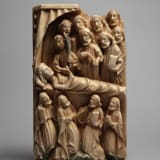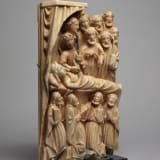


The Death of the Virgin
The Death, or Dormition, of the Virgin (a scene not mentioned in the Bible but instead derived from an apocryphal text) takes place as she lays in her deathbed, its bedclothes drawn around her torso and under her arms. Her body and the bed on which she lies bisect the composition through its horizontal centre line, neatly differentiating the four apostles kneeling in the foreground from the eight who stand behind her and lower their heads to look towards her face. This clean spatial arrangement is given a single vertical boundary by a tall tester canopy, which borders the panel at its top left corner, and from which its hanging draperies are cut away rather than drawn back to frame the men who gather closely beneath its shadow.
This relief was probably carved for an altarpiece dedicated to the Life of the Virgin, but today it is one of only three recorded examples depicting her Dormition that are known to have come down to us. The other two are at Saint Mary’s College of Education in Strawberry Hill, and in the Victoria and Albert Museum. In the nineteenth century, our panel was incorporated along with sixteen others into a reredos arrangement in the chapel of the Chateau du Breuil-Benoît in Normandy. Evidently united from several separate altarpieces, they highlight how the majority of English alabasters survived the Reformation of the 1540s purely by dint of having been exported to Europe when iconoclastic fervour started to spread across the country, rather than remaining in English contexts to suffer the fate of their many lost counterparts.








